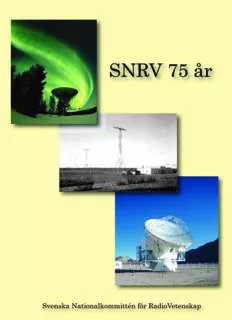Table Of ContentSNRV 75 år
Svenska Nationalkommittén för RadioVetenskap
(cid:190) (cid:187)
Omslagetsbilder
Uppifra˚n: Eiscat (Foto: Eiscat), Grimeton (Foto: Gustaf
Bjo¨rkstro¨m, la¨nsmuseet i Varberg) och APEX (Foto: Per
Bergman).
(cid:189) (cid:188)
SNRV 75 år
Redaktör: Gerhard Kristensson
(cid:176)c 2009SvenskaNationalkommitte´nfo¨rRadioVetenskap,SNRV
ISBN978-91-977603-0-0
PrintedinSwedenby TryckerietiE-huset,Lund
Inneha˚ll
Inneha˚ll i
Fo¨rord iii
JeanVanBladel:TheearlyhistoryofURSI 1
StaffanStro¨m:CommissionB:GreatGuns! 13
MatsBa¨ckstro¨m:Elektromagnetiskahotmotdetmodernasamha¨llet 23
A˚keBlomquist: SNRV:sochSektionF:shistoria 37
BengtHultqvist:Svenskrymdfysikforskningmedradiova˚gorunderdetsenastehalv-
seklet:Hurvifickeninternationellforskningsanla¨ggningmedsa¨teiSverige 45
RoyBooth: OnsalaSpaceObservatory1990–2005 61
Carl-HenrikWalde:Radiohistoriaochva¨rldsarvetGrimeton 91
Sakregister 105
i
ii Inneha˚ll
Fo¨rord
Den 20 mars 1931 beslutade Kungl. Maj:t att inra¨tta Svenska Nationalkommitte´n fo¨r
Radiovetenskap, SNRV (fra˚n starten bena¨mnd: Svenska Nationalkommitte´n fo¨r Veten-
skaplig Radiotelegrafi, SNVR). Pa˚ dagen 75 a˚r senare, den 20 mars 2006, uppma¨rksam-
mades detta jubileum genom ett mycket va¨lbeso¨kt seminarium pa˚ Kungliga Vetenskaps-
akademien, KVA, som a¨r nationalkommitte´ns huvudman. Programmet, se nedan, illust-
rerar pa˚ ett mycket tydligt sa¨tt den aktivitet och den rika spa¨nnvidd som SNRV represen-
terariba˚dedagensochdega˚ngnaa˚rensverksamheter.
Jubileetsprogramden20mars2006
1. JeanVanBladel:URSI-historia
2. A˚keBlomquist:SNRV-historia
3. BengtHultqvist:Svenskrymdforskningmedradiova˚gorunderdetsenastehalvsek-
let
4. StaffanStro¨m:CommissionB:TheBasics!
5. Mikael O¨stling: Den rekordsnabba utvecklingen inom nanoelektroniken och fo-
toniken
6. Carl-HenrikWalde: Radiohistoriaochva¨rldsarvetGrimeton
7. O¨stenMa¨kitalo: Mobiltelefonihistoriaochutblickmotframtiden
8. MatsBa¨ckstro¨m:Elektromagnetiskahotmotdetmodernasamha¨llet
Uto¨ver dessa la¨ngre presentationer gavs dessutom tva˚ kortare anfo¨randen av Gudmund
Wannberg om det framtida Eiscat-projektet och av Erik Kollberg om Onsala rymdobser-
vatoriumsverksamhet.
Som tydligt framga˚r av ovansta˚ende program ta¨cks i stort sett samtliga nationalkom-
mitte´ns sektioner in rent vetenskapligt. Viktiga nationella anla¨ggningar som Eiscat och
IRFiKiruna,OnsalaRymdobservatoriumsamtva¨rldsarvetVarbergRadioiGrimetonho¨r
naturligtvis hemma i ett jubileumsprogram av det ha¨r slaget liksom historiska tillbaka-
blickarochsummeringaravteknikutvecklingar.Defo¨redrag,somiskrift a¨rdokumenter-
adefra˚njubileet,presenterasidennabok.
SNRVrepresenterarochfo¨retra¨dersvenskradioforskning.Dessfra¨mstarolla¨rattver-
ka som na¨tverksbildare och expertorgan i radiofra˚gor, Na¨tverksbildandet sker inte minst
iii
iv Fo¨rord
genom de olika serier av konferenser som anordnas i SNRV:s regi, t.ex. RVK, EMB
och GHz. Hit kan fo¨ras a¨ven de symposier, seminarier och kortva˚gskonferenser som ar-
rangerasavdenSNRVsto¨djandestiftelsenNordiskaRadioSamfundet,NRS.
SvenskaNationalkommitte´nfo¨rRadiovetenskapvillmeddennaskriftuppma¨rksamma
denstarkautvecklingochdencentralarollsomSverigeharhaft,ochidagsla¨gethar,inom
radio. Detta ga¨ller sa˚va¨l pa˚ den nationella arenan som pa˚ den internationella. Flera av
jubileets fo¨redrag illustrerade detta och delar av denna utveckling finns skildrad i denna
skrift. Huvudsyftet med jubileumsboken a¨r att skildra och sammanfatta de senaste 15
a˚rensutveckling,mendetfinnsocksa˚ anledningattblickala¨ngretillbakaitidenfo¨rattfa˚
en kontinuerlig o¨verga˚ng fra˚n de tidigare jubileumsskrifterna SNRV 50 a˚r och SNRV 60
a˚r.
Slutligen vill SNRV rikta ett stort tack till alla bidragande fo¨rfattare, och ett sa¨rskilt
tack till KVA fo¨r mo¨jligheten att genomfo¨ra jubileet i dess lokaler samt fo¨r ekonomiskt
bidragtillskriftenstryckning.
Lund,30april2009
GerhardKristensson
Ordfo¨randeSNRV
VanBladel:TheearlyhistoryofURSI 1
The early history of URSI
JeanVanBladel
HonorarypresidentofURSI
By the last decade of the 19th century, communications ”without wires” started devel-
oping rapidly. Initially the ranges were modest, but Marconi managed to increase them
progressively,firstattaininga110kmreachoverwaterin1899,andfinallysucceedingin
creatingaradiolinkacrosstheAtlanticOceanin1901,fromCornwalltoNewfoundland.
Beforethathistoricachievement,radiocommunicationsfromshiptoshorehadstartedin
1898, and from 1900 on ships became increasingly equipped with wireless equipment.
This new technology triggered the interest of the industrialized world, and the use of
”radio” spread explosively. By 1904, for instance, daily bulletins were provided for pas-
sengersoftheCunardLinebymeansofsignalspickedupduringthetransoceanicjourney
fromasuccessionofshorestations(Figure1).
In 1910 the general public followed with excitement how Dr. Crippen, a suspect in
the murder of his wife, was arrested with the help of radio. Crippen, feeling England
was becoming too hot for comfort, had boarded the Montrose in Antwerp, heading for
the safety of Quebec. Although he traveled in disguise, he was recognized by the ship’s
captain, who alerted Scotland Yard by radio. The inspector in charge of the case boarded
a fast ship, the Laurentic, reaching Canada before the Montrose. Crippen was totally
unawareofthechase,andwaseasilyinterceptedandarrestedinCanadianwaters.
Radio communications were also involved in the drama of the Titanic, which struck
an iceberg during its maiden voyage, just before midnight on April 14, 1912. A small
passenger ship, the California, was in the vicinity, had noticed the presence of an icefield
intheevening,andsoughttowarntheTitanicbyradio. ButtheTitanic’soperator,Phillips,
wasbusyexchangingmessageswithCapeCodatthetime. HetoldEvans,theCalifornia’s
radiotelegraphist, to leave him alone, upon which Evans went to sleep. It was only after
the collision, around midnight, that the Titanic started transmitting distress signals. They
were eventually picked up by the Carpathia, which unfortunately was five hours’ sailing
away, and did not reach the Titanic until daybreak. Several vessels were closer by, but
werenotequippedforwirelesscommunications,andthereforecouldnotbealerted.
First international cooperation
From 1900 on, a fierce competition started for the domination of the radiocommunica-
tion market. Several commercial systems soon became available. In 1905, for example,
customers could chose between the products of the de Forest Company, the Telefunken
Company (which received technical advice from Wien, who was later involved in the
birth of URSI) and the Marconi company (which had Edison and Pupin as its advisors).
Meanwhile Marconi was trying to create a de facto monopoly by restricting the traffic
within his own system to reception and transmission by means of his own equipment.
Distress signals from differently equipped ships would therefore remain undetected. In
ordertoremedythispotentiallydisastroussituationaseriesofadministrativeconferences
2 VanBladel:TheearlyhistoryofURSI
Figure1: CunardDailyBulletin.
wasorganized,thefirstofwhichwasheldinBerlinin1903. Theseconferencesmaderec-
ommendations on such matters as the allocation of frequencies, the form of signals from
radio beacons and the transmission of weather reports and time data. The meetings were
primarily government affairs; it is only around 1913 that the need for scientific cooper-
ation came to the fore. How this led to the birth of URSI was initiated by the following
eventsinEquatorialAfrica.
Description:took place on October 13, 1913 in the gardens of the Royal Palace of Laken, near . De Maxwellska ekvationerna utgör basen för URSI:s alla olika

